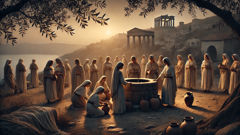Introduction
They called them the Danaïdes because they were daughters of Danaus, a name that carried the salt of shorelines and the hush of palace halls. In the sun-struck valleys of Argos, where olive trees kept time with seasons and stone thresholds recorded the passing of many feet, fifty sisters learned the household crafts of women of their station: spinning flax, drawing water, tending oil lamps, and listening to the measured, patient speech of elders. But they were not only daughters in the private sense. In legend and in law, they represented a line of duty and a line of rumor, a single thread braided into the fate of a city and the anger of distant kin. Danaus, who fled with his daughters from an unwelcome union with the sons of Aegyptus, raised them under the strained calm of exile, teaching them self-preservation beneath the lacquer of piety. Yet marriages were demanded, alliances formed through the crossing of borders and the calculation of power, and in one long, tremulous night, the girls—so alike in feature that strangers sometimes mistook one for another—were given knives that would split the arc of their lives. The choices they made and the one they did not make became a story told at hearths for centuries: a story about the burden of loyalty, the cost of defiance, and how mercy and condemnation can both befall the same heart. This is that tale, reimagined and expanded—an interior map of motive and consequence carved into the memory of myth, where the sieve fills and empties forever, where water becomes the measure of an unquiet justice and the daughters become both victims and architects of their destiny.
House of Danaus: Flight, Bargains, and a Night of Knives
Danaus’s household was a place where strategies were spoken in the measured economy of silence. He had come from a land of river and delta, bringing with him a lineage shaped by long summers and fields of papyrus, and he brought the habit of counting obligations as if they were grain. When the sons of Aegyptus pursued him with offers of marriage for each daughter, they came not with poems or tokens but with the weight of politics. A union of families meant a new thread in a net of alliances, and in those days alliances could bend the courses of cities.

So Danaus fled. He carried fifty daughters like a secret under his wing, each girl a mirror of another, each given names that often blurred into devotion and duty. In Argos they were welcomed for reasons that had nothing to do with warmth. A king may have extended shelter, counting the advantages of harboring a fugitive noble; Argos may have seen in the arrival of Danaus’s line a new resource, a way to bind a foreign house into local soil. Yet under the polished veneer of integration lay unease, for the daughters were always reminders of the unsettled bargain that still lived in the shadows of their new home.
Danaus raised his daughters with instruction and vigilance. When the sons of Aegyptus arrived to fulfill their claim—bold, armored, and insistent—the palace hummed with the low, sharp music of preparation. Marriage feasts were laid out: roasted lamb, barley loaves, honeyed figs, and pitchers of wine that shone like captured sunlight. But in private corners of the palace, under the wan glow of oil lamps, Danaus and his girls whispered of a different feast: one of escape, of knives hidden beneath skirts. He spoke to them not as cynically as rumor suggested but with a hardened care. The daughters were to obey him as daughters did in those customs—yet he taught them how to keep their hands swift and their faces soft as alabaster. He told them of betrayal and of a father’s duty to preserve his house. He may have painted a picture of necessity that left no room for softness.
The wedding night arrives, and the corridors of the palace echo with the footfalls of men and women who do not know the threads already braided into their destinies. Each marriage is consummated by custom and bed, but the consummation in this tale is not the soft discovery of two lives but the turning of a key in a lock. With the hush of midnight, inspired by a single, somber command, the sisters went to their rooms. In many versions of the myth, all but one—Hypermnestra—obeyed the father’s cruel instruction. Hypermnestra spared Lynceus because of an oath of hospitality, or because love had stirred in her chest, depending on which storyteller you trust. She could not bring herself to strike a sleeping man who had treated her kindly. For the other forty-nine, the blade was swift, and the sound was the small, almost inaudible signing of life slipping away. That sound rippled outward like a hidden tide.
What do we make of that night? The narrative is small and harsh: daughters shape the death of their new husbands by obeying their father. Yet each sister’s motive is a tangle. Some obey out of terror—fear of paternal wrath, knowledge that refusal would mean exile or worse. Some obey because they have been taught to think of the family as a sovereign body whose survival eclipses individual sentiment. Some may have been convinced that by ending a marriage they were protecting their line from ruin. Others may have felt that their only means of acting in a world that had handed them little agency was to choose the one form of action still permitted: violence. There is an ambiguity in that night that refuses to be simplified. It is a portrait of women pressed between the imperatives of blood and the abrupt, private logic of self-defense or revenge.
Hypermnestra’s decision complicates the neat symmetry of the deed. By sparing Lynceus, she sparks a tale of love and vengeance that will loop through generations: Lynceus survives and later avenges his brothers, becoming ancestor to a line that will shape the political tapestry of Argos. Hypermnestra’s mercy is the seed of a future reign. Yet this mercy becomes a wound for the other sisters. They are painted by history in a different light—less merciful, more culpable. That dichotomy is the pivot of how cultures remember their own pasts: a single act of compassion may redeem one and condemn many.
When justice, as mortals think of it, presses down, it often consults the gods. The Danaïdes were not merely subject to the laws of men. Their crime reverberated in taverns, temples, and the courts of Olympus. The story settles into myth not only because it is sensational but because it asks such persistent questions about the shape of responsibility. Who is accountable when a father commands and daughters obey? Is a woman who kills under duress differently judged than a man who kills for gain? By ancient Athens’ moral scales, the sisters failed an essential test, and so their punishment was pronounced: an eternal task fit to the measure of their deed. They would be condemned to carry water—an act forever incomplete, for the vessels that held their burden were sieves.
The image hardened: fifty women bent beneath impossible vessels, water leaking away as fast as hands could lift it. It is a punishment that carries the geometry of irony. Water, life-giving and pure, becomes a measure of guilt; a sieve, meant to separate, becomes a paradoxical prison. Some interpreters of the myth imagine the Danaïdes not as tormented wretches but as figures of perpetual labor—symbols of a people’s endless exertion, the cyclical toil that never attains its end. Others read the scene as cosmic commentary on a crime that cannot be undone: the measure poured out is memory itself. Each drop that falls is a remembrance lost and found and lost again.
Yet beneath the drama and the pronouncement of fate, the Danaïdes remain complex. The story offers no single moral decree; instead it hands us the tools to ask uncomfortable questions about obedience, about the reach of paternal authority, and about how societies fashion women’s choices into either virtue or vice. The daughters are not only perpetrators; they are the unhappy registers of a father’s fear, of a city’s politics, and of a world that expects them to resolve impossible contradictions with nothing but a knife and the courage to follow orders.
Language grows around them. Poets imagine their faces at dawn; orators brandish their story in speeches about laws; mothers warn daughters about men with the memory of that night. In the end, the Danaïdes live in a place between history and teaching: a myth that both instructs and confounds, endlessly useful because it resists being only one thing. Their punishment—sisyphian and fated—asks us to stand beside them in the dusk and listen to the small, endless sound of water escaping through holes, the same sound that presses at the edges of conscience and the edge of myth itself.
Under the Judgment of the Gods: Sieve, Water, and the Measure of Memory
When the verdict came from the temples and the poets had shaped its edges with their tongues, the Danaïdes were given a punishment that would mark them out of time. Sentenced to the underworld, they were tasked to fill leaky jars with water from an endless spring; the water always slipped through the sieve, and forever the jars remained insufficient, the task eternally renewing itself. That image—women enduring a labor that cannot succeed—became one of the most memorable in Greek imagination. It is an archetype of futility, and its resonance is not merely punitive. The sieve is a symbol, a piece of rhetorical geometry designed to make the moral lesson visible to every passerby who will listen to the myth.

To place punishment in the afterlife is to set a horizon where culture can work on memory without the interference of political expediency. In life, killings are messy and entangled with motive; in myth, the divine can render a tidy harmony—cause and consequence arranged in marble columns. Yet even here there are fissures. The nature of the Danaïdes’ work—water filtered and lost—speaks to something deeper than mere retribution. Water is habitually the image of life and cleansing. The punishment thus has the flavor of perverse purification: an attempt to wash away guilt that yields only the permanence of labor. The effort to cleanse becomes the very thing that binds the guilty to guilt. The Danaïdes are not wiped clean; they are set to perpetual reminder.
There is also a gendered tension to the sentence. In a society where women were frequently identified with domestic labor—fetching water, caring for the hearth, weaving—this eternal task converts daily, benign labors into a cosmic symbol of guilt. The penalty inverts ordinary female competence and turns it into punishment. The irony cuts both ways; it is not merely a comedic barb but a commentary on social structure: the things a woman does by habit, by social role, become her prison when reinterpreted as penance.
Scholars and storytellers have sought layers in the myth. Some suggest the Danaïdes represent an older ritual motif, perhaps derived from fertility rites or from an agricultural metaphor about barren land and unending toil. Others see in their punishment an allegory of political resistance: a portrayal of women who exercised lethal agency, punished by having the very symbol of life and sustenance rendered useless. In more philosophical readings, the sieve is a metaphor for memory itself; no matter how much we pour into the past, we cannot reconstruct what we have lost. Our recollections trickle away, each drop a shard of story falling into depths from which it seldom returns.
The tension between law and mercy also threads through the ending of the tale. Hypermnestra, who spared Lynceus, was not consigned to the same doom in all tellings. In some versions, her mercy leads to reconciliation and an eventual lineage that rules; in others, even she is judged and must undertake her own penance. The two narrative poles—mercy rewarded and cruelty punished—coexist in myth because human motives rarely submit to final adjudication. The ancients used these contradictions to teach, to warn, and to explain political outcomes. A single decision by a woman could be held responsible for the rise of a dynasty or the moral stain of a people.
There is a grim kind of poetry in the picture of the Danaïdes at the spring. Imagine fifty figures under a low-arched cavern, each with a sieve that will not hold water. Light catches on the rims; the drip becomes the narrative’s metronome. The sisters work in parallel, shoulder to shoulder, their tunics darkened at the hems by moisture. There is no conversation left to them that matters; speech is exhausted. Occasionally a hand falters, a head bows, or a woman looks toward the faint glow that presides over the underworld and thinks, perhaps, of the life she had once touched: a bowl of figs, the feel of a child’s fingers, a whisper from her mother. Those memories press at the sieve; they fall like clear beads and are gone.
Yet even in their endless labor the Danaïdes are not stripped of dignity. Mythic punishment can degrade, but it can also illuminate resilience. Each sister persists in the face of a task that cannot be completed, and that persistence becomes a testament to the human capacity for endurance. Poets have long admired this aspect: there is a terrible nobility to continuing despite assured futility. The image reaches modern readers with a pity that is almost compassionate: we watch and feel the sisters’ effort as a reflection of our own smallest, stubborn labors—the work to keep a household together, the attempt to rebuild after loss, the daily insistence that life be met with hands that do not give up.
The Danaïdes’ punishment has been echoed and adapted through ages. In Roman retellings it is used as rhetorical device; in Renaissance paintings it is rendered with baroque drama; in modern literature it appears as metaphor for bureaucratic absurdity or as feminist critique of gendered expectations. Contemporary readers can see in their plight the shape of many modern dilemmas: the women compelled to act under patriarchal pressure, the individuals trapped in systems that reward obedience with silence, and the societies that remember some wrongs while excusing others. The sieve becomes a lens through which to view the larger human picture: the fragments of history that slip through our fingers and the ways we assign blame and invent punishment to hold on to order.
Finally, the myth invites us to ask whether punishment in myth is ever truly about retribution or whether it is primarily a way to hold memory in a visible form. By condemning the Danaïdes to an endless, public task, the gods and poets lay down a mnemonic device: do not forget what happened here. But memory has its own erosions. Even as each drop falls and is lost, the story of the Danaïdes continues to be told, retold, and re-interpreted. Their labor is endless, but so too is the human conversation they provoke: about justice, about the limits of obedience, about whether mercy should have power to alter destiny. As long as someone reads the story and feels its chill and its tenderness, the sieve will never be empty of meaning.
Conclusion
The Tale of the Danaïdes is more than a grotesque parable of crime and punishment; it is a mirror held up to questions about authority, gender, and the obligations that families and societies impose. The image of fifty women, forever serving a task that can never be completed, is at once a condemnation and a compassion: a condemnation because it fixes their guilt in a visible, unending form; a compassion because it recognizes endurance as a human attribute that can survive judgment. Modern readers can approach the Danaïdes not merely as figures to be pitied or reviled but as complex agents caught in the eddies of power and tradition. Their knives, their mercy, and their sieves all speak to the difficult choices people make when the alternatives are constrained. When we reflect on their story we are invited to consider how we assign responsibility, how we remember wrongs, and how we fashion narratives that make sense of violence and mercy. Perhaps the most lasting lesson is this: myths keep asking us to look at ourselves and to reckon with the ways communities demand loyalty, and the ways individuals must answer—sometimes with acts that echo down centuries. The sieve will never hold, and yet the story endures, each retelling another small measure poured into a vessel that carries human memory forward.













